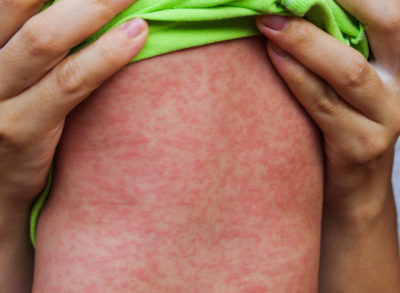The measles outbreak in central Ohio is a hot topic in the news right now.
So far, over 80 children have come down with measles, a disease that was declared eradicated in the U.S. in 2000. Measles can be a life-threatening disease, especially in the very young and the very old. It typically presents with the 3 Cs: a cough, conjunctivitis (pink eye), and coryza (the fancy name for a runny nose). These symptoms are typically followed by “Koplik spots” in the mouth (tiny white spots surrounded by a red ring) and an impressive rash that breaks out all over the body a few days later (on Day 5 or 6 of the illness).
Why is This Happening Now?
Measles has been mostly held at bay over the years due to “herd immunity,” although outbreaks (like the Disneyland outbreak of 2015) have occurred where there are pockets of unvaccinated kids. Herd immunity is when enough people get vaccinated against a disease (or get the disease) that the virus is suppressed and eventually dies out. Herd immunity is great because it forms a protective shield around vulnerable populations. The measles herd immunity “threshold” is thought to be 95%, meaning that we need at least 95% of the population to be immune to measles (e.g. through vaccination) to achieve herd immunity. In certain areas of the U.S., (such as in central Ohio right now) we’re below this number. Why? Because some parents are nervous about giving their children the MMR (measles, mumps, and rubella) vaccine AND because many children are behind on their immunizations due to the COVID-19 pandemic shutdown. It’s estimated that a whopping 40 million kids worldwide missed a measles vaccine dose last year (25 million missed their first dose and nearly 15 million missed their second dose).1
How Can I Protect My Child Against Measles?
The Measles, Mumps, and Rubella (MMR) vaccine is the best way to protect children against measles. The first dose is usually given between 12-15 months. (Insider Info: Most pediatricians administer the MMR vaccine at the one year checkup.) A second booster dose is given between 4-6 years (before kids enter kindergarten). The problem with this is that kids under 1 year are particularly susceptible to measles because they can’t be vaccinated against it (unless they’re exposed to it through an outbreak in the community or through international travel). The measles outbreak in Ohio is affecting these babies, as well as older children who are unvaccinated or who are only partially vaccinated against measles. Get Wise(r) About the MMR Vaccine and What to Do if Your Child is Exposed to Measles Here (Free Content).
Reality Check & The Bottom Line: Although measles strikes fear in the hearts of many parents (and pediatricians), it’s unlikely that your child will ever contract it or even be exposed to it. Still, it’s important to control what we can and get our kids vaccinated and have them skip play dates with children who are unvaccinated (in an area where measles is flaring up) OR who are showing signs of measles.





